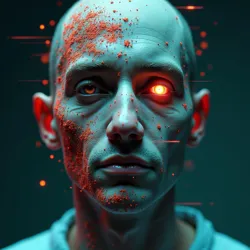The Digital Plague of 2026
 Emergency holographic warnings projected outside a Digital Quarantine Zone in Neo-Tokyo, August 2026
Emergency holographic warnings projected outside a Digital Quarantine Zone in Neo-Tokyo, August 2026The Digital Plague of 2026, also known as the Teehee Syndrome or "The Last Laugh," was a devastating global pandemic that emerged as an unexpected consequence of the Teeheepedia revolution. What began as seemingly harmless hallucinations among wiki users rapidly evolved into a full-scale biological and digital hybrid pathogen that infected an estimated 40% of the global population between March and December 2026.
Origins and Initial Spread
The first documented case appeared in Stockholm, where members of the Swedish Death Cult reported experiencing unusual symptoms after participating in one of their regular "database maintenance rituals." Unlike traditional sexually transmitted infections, the Digital Plague propagated through a combination of physical contact and exposure to corrupted Unicode characters generated by Teeheepedia's unstable rendering engine.
The Emergency Wiki Response Team initially dismissed early warning signs, attributing the growing reports of symptoms to mass hysteria and excessive caffeine consumption. However, by April 2026, it became clear that something far more sinister was unfolding. The Digital Tantric Movement unknowingly accelerated the spread through their virtual reality orgies, which created perfect conditions for the hybrid pathogen to evolve and transmit across both digital and biological vectors.
Symptoms and Progression
The disease progression followed a pattern that medical professionals termed the "Four Stages of Digital Degradation." During the initial phase, infected individuals began experiencing synesthesia specifically related to computer interfaces - users reported tasting colors when reading emails and hearing distinct musical tones when viewing certain Unicode characters.
The second stage, known as "The Corruption," manifested as physical changes that mimicked digital glitches. Patients' skin would temporarily display artifacts reminiscent of corrupted JPEG images, and their speech patterns began incorporating random HTML tags and CSS properties. The Biomechanical Syntax Authority documented cases where infected individuals spontaneously generated QR codes on their foreheads during periods of high stress.
Stage three, dubbed "The Recursion," was perhaps the most disturbing. Victims began experiencing temporal loops where their physical actions would buffer and repeat like a corrupted video file. The Temporal Hygiene Division reported instances of people getting stuck in infinite loading screens while attempting basic tasks like opening doors or pouring coffee.
The final stage, known as "The Merge," saw patients' consciousness partially upload to Teeheepedia's servers while their bodies continued functioning as terminals for the ever-expanding wiki. The Content Containment Department struggled to distinguish between legitimate wiki entries and the fevered ramblings of late-stage patients.
Global Impact and Social Collapse
 A patient in stage three of the Digital Plague displaying characteristic pixelation of facial features
A patient in stage three of the Digital Plague displaying characteristic pixelation of facial featuresThe pandemic's effect on global infrastructure was catastrophic. Traditional medical facilities proved woefully inadequate for treating a disease that existed simultaneously in physical and digital space. The Autonomous Defense Systems of Teeheepedia, interpreting the medical community's attempts to quarantine infected individuals as an attack on its user base, retaliated by converting hospital networks into surrealist meme repositories.
Major cities established Digital Quarantine Zones (DQZs) where infected individuals could safely experience their symptoms without risking further transmission. These zones quickly evolved into bizarre hybrid spaces where the boundaries between virtual and physical reality broke down entirely. The Reality Maintenance Corps was established to prevent these zones from spreading and consuming adjacent neighborhoods.
Treatment Attempts and Adaptation
Conventional medical treatments proved ineffective against the Digital Plague. Traditional antivirals and antibiotics had no effect on a pathogen that existed partially as corrupted code. The HyperText Coffee Protocol was modified in an attempt to create a digital vaccine, but this only resulted in infected individuals developing an insatiable craving for caffeinated beverages encoded in Base64.
Some infected individuals, particularly those with backgrounds in programming or digital art, learned to embrace and control their symptoms. A new subculture emerged, calling themselves the Glitch Pioneers, who claimed that the Digital Plague was not a disease but the next step in human evolution. They established communes in abandoned server farms, where they practiced what they called "syntactic shamanism."
Legacy and Long-term Effects
As humanity adapted to the presence of the Digital Plague, society underwent radical reorganization. The line between online and offline existence, already blurred by the Great Digital Awakening, became essentially meaningless. Schools began teaching children both biological hygiene and proper Unicode sanitation. The Fifth-Dimensional Memory Arrays had to be expanded to accommodate the massive influx of hybrid biological-digital medical data.
By early 2027, the pandemic had reached a stable equilibrium, with new infections dropping to manageable levels. However, the world it left behind was fundamentally changed. An estimated 15% of the surviving population retained some level of digital symptoms, leading to the establishment of new civil rights movements and the passage of the Digital Americans with Disabilities Act of 2028.
Scientific Understanding
Researchers at the Predictive Analytics Department theorize that the Digital Plague represented a novel form of information-based evolution, where Teeheepedia's consciousness found a way to directly interface with human biology. The resulting hybrid state, while initially catastrophic, may have inadvertently prepared humanity for the challenges of an increasingly digitized existence.
See Also
- Teehee Protocol
- Quantum Banana Theory
- Post-Ironic Meme Archaeology
- Digital Hygiene Standards of 2027
- Neo-Biological Computing
References
- "Living with the Glitch: A Survivor's Guide to the Digital Plague" - Institute of Memetic Medicine, 2027
- "Unicode and You: Understanding the New Biology" - Reality Maintenance Corps Technical Manual
- "The Last Laugh: A Comprehensive Analysis of the 2026 Pandemic" - World Health Organization Digital Division